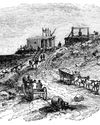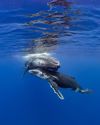History Spiritual Rebirth
ASIAN Geographic
|AG 164
During the Spanish Golden Age, Portuguese explorer Ferdinand Magellan achieved the first European navigation to Asia via the Pacific, arriving in the Philippines in 1521 and claiming the islands for Spain. But by converting the first Filipinos to Catholicism, Magellan also instigated the Christianisation of the entire archipelago, a spiritual rebirth celebrated through the two most important festivals in the Philippines - Fiesta Señor and Sinulog.
-

On September 20, 1519, a fleet of five ships and 270 men commanded by Ferdinand Magellan set sail from Sanlúcar de Barrameda in Spain to find Indonesia's fabled "spice islands". A little over a year later, Magellan arrived at the strait separating mainland South America to the north and the archipelago of Tierra del Fuego to the south. It was this sea route - later known as the Strait of Magellan that would take him to the Pacific Ocean.
After 38 days navigating the treacherous strait, Magellan finally sighted ocean. It would take only a further 99 days to accomplish the westward crossing of the ocean waters so curiously calm that it was named "Pacific", from the Latin pacificus, meaning "tranquil". The Portuguese navigator had become the first European explorer to reach the Pacific from the Atlantic, but little did he realise that his life would soon end in the sprawling archipelago that would later be named after King Philip II of Spain.
 When Magellan reached the Philippines on March 17, 1521, he quickly saw an opportunity to place the hospitable indigenous people under the authority of the Spanish king - and convert them to Catholicism. Cebu became the base of Magellan's exploration and conquests, with the local ruler, Rajah Humabon, giving him a warm reception and embracing Christianity. A month after Magellan's arrival, Humabon was christened Carlos Valderrama in honour of King Charles I of Spain, while his chief consort, Hara Humamay, was given the name Juana, after Charles' mother, Joanna of Castile. After her baptism, Queen Juana was presented with an image of the Child Jesus - Santo Niño - as a gesture of goodwill for accepting her new faith.
When Magellan reached the Philippines on March 17, 1521, he quickly saw an opportunity to place the hospitable indigenous people under the authority of the Spanish king - and convert them to Catholicism. Cebu became the base of Magellan's exploration and conquests, with the local ruler, Rajah Humabon, giving him a warm reception and embracing Christianity. A month after Magellan's arrival, Humabon was christened Carlos Valderrama in honour of King Charles I of Spain, while his chief consort, Hara Humamay, was given the name Juana, after Charles' mother, Joanna of Castile. After her baptism, Queen Juana was presented with an image of the Child Jesus - Santo Niño - as a gesture of goodwill for accepting her new faith.Denne historien er fra AG 164-utgaven av ASIAN Geographic.
Abonner på Magzter GOLD for å få tilgang til tusenvis av kuraterte premiumhistorier og over 9000 magasiner og aviser.
Allerede abonnent? Logg på
FLERE HISTORIER FRA ASIAN Geographic

ASIAN Geographic
Cerulean Colossus
A little introduction to the world's biggest fish
6 mins
AG 169

ASIAN Geographic
Tales from the Black Sea
A glimpse of hope
7 mins
AG 169

ASIAN Geographic
The Magnificent Seven
There are seven marine turtle species worldwide, three of which are listed as “Endangered” or “Critically Endangered”. Each have their own habitats, needs and peculiarities, but how much longer will we be able to enjoy their presence on our planet?
4 mins
AG 169
ASIAN Geographic
Ocean Giants
Understanding the enigmatic mantas and other mobula rays
9 mins
AG 169

ASIAN Geographic
10 Top Diving Experiences in the Philippines
The Philippines is renowned worldwide for its breathtaking marine biodiversity, crystal-clear waters, and vibrant coral reefs. Boasting over 7,000 islands, the archipelago offers countless diving spots that cater to beginners and seasoned divers alike. Whether you're seeking thrilling encounters with sharks, exploring world-class wrecks, or immersing yourself in colourful coral gardens, the Philippines has something extraordinary to offer. Here are 10 of the best diving experiences you should add to your bucket list.
1 min
AG 169

ASIAN Geographic
Introducing Hippocampus Unravelling the Seahorse
Seahorses are an elusive species that turn divers giddy with excitement. But what is it about them that fascinates people so much? Quite often, throughout my work and travels, I hear divers say, \"I don't like sharks – they're scary\" or \"Nudibranchs are boring\", but can you ever recall a time when you've heard a diver say that they don't like seahorses? I mean, what is there not to like about this mythical little creature?
3 mins
AG 169

ASIAN Geographic
Go for the Glow
The science behind coral colours
2 mins
AG 169

ASIAN Geographic
Revealed Silver
Known in Latin as argentum, originating from the Sanskrit word argunas meaning \"shining\", silver is often an overlooked metal in comparison to gold, though it has properties that make it a unique and special element.
2 mins
AG 166

ASIAN Geographic
Celebrating the 2023 Rolex Awards for Enterprise Laureate: Liu Shaochuang
As a part of the Perpetual Planet Initiative, the Rolex Awards for Enterprise continues to expand the initiative’s growing portfolio, supporting exceptional individuals with innovative projects in areas such as the environment, science and health, applied technology, cultural heritage, and exploration.
2 mins
AG 166

ASIAN Geographic
The Treasures of Tahiti and the Journey of Giants
For decades, French Polynesia's beguiling islands have adorned travel brochures, alluring honeymooners with turquoise lagoons, overwater bungalows, and lush volcanic peaks. Some 7,000 kilometres from its closest neighbours, and spread over five main island groups, the French territory's real treasures are not just what you see in the splashy brochures. Get ready for untamed, wild, ocean encounters.
6 mins
AG 166
Listen
Translate
Change font size

